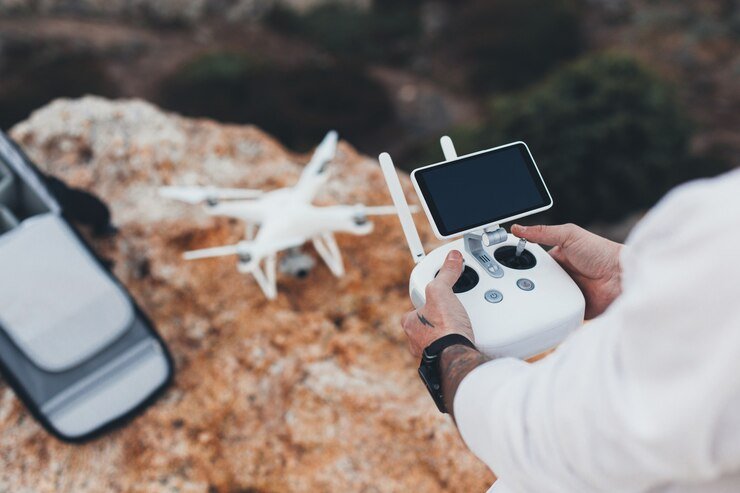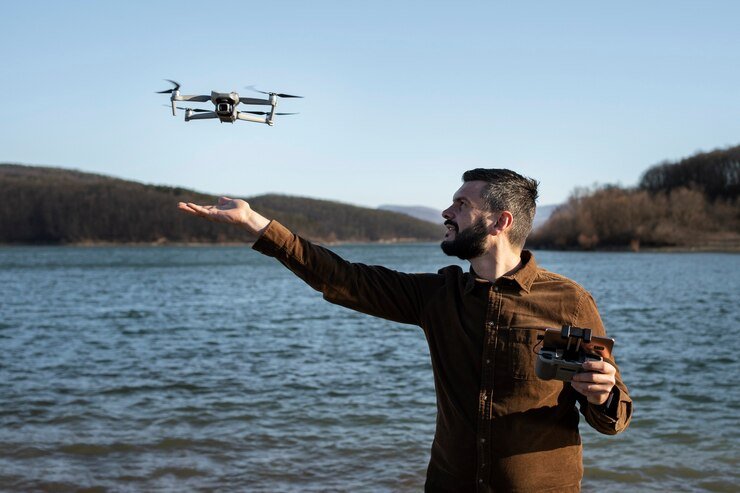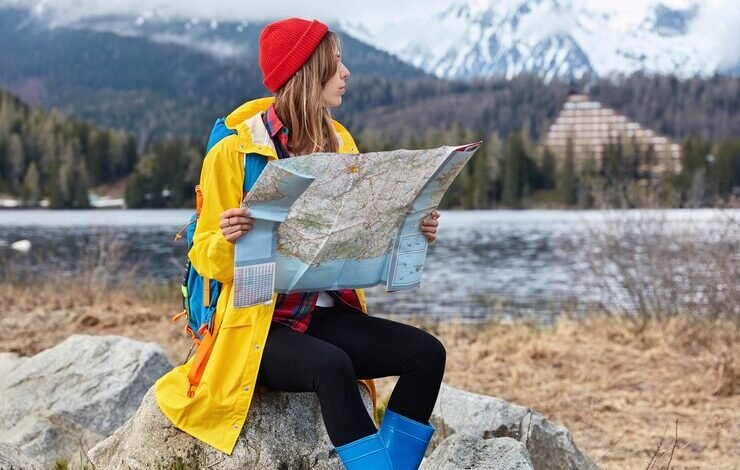
How to Find the Best Places to Take Drone Photography:
Table of Contents
ToggleIntroduction:
The development of robots in recent years has changed photography, providing offering fans and experts alike with the valuable chance to capture stunning aeronautical perspectives. Take Drone photography opens up a very surprising universe of innovative possible results, thinking about stand-out focuses and stunning vistas that were once inaccessible.
Comprehending the Legal Factors :
Preceding setting out on a robot photography experience, it is basic to truly get to realize the legal rules managing drone usage in your space. Different countries and districts have moving standards and limits, which could integrate rise confines, no fly zones, and insurance concerns. Acquire any necessary permits, learn about any new or updated rules, and thoroughly familiarize yourself with the regulations set forth by the nearby flight authority. It is essential to comprehend the legal considerations that govern such activities when engaging in drone photography near your location. Consider these important points:

Regulations:
Get to know the guidelines set out by the applicable flying expert in your nation or locale. These guidelines ordinarily cover perspectives, for example, flight height limits, vicinity to air terminals, and confined airspace.
Licenses and Permits:
Contingent upon your area and the motivation behind your robot photography, you might have to get allows or licenses. Beyond what is required for recreational use, commercial drone operations frequently require additional authorization.
Security Regulations:
When using a drone to take photos or videos, be considerate of the privacy rights of other people. Security Regulations: Be aware of neighborhood protection regulations and guidelines, particularly while flying over confidential property or catching pictures of people without their assent.
Safety Instructions:
Comply with wellbeing rules given by avionics specialists and industry organizations. This incorporates leading pre-flight checks, keeping up with view with the robot, and staying away from dangerous weather patterns.
Environmental Factors to Consider:
When flying your drone, be mindful of environmental regulations and concerns. Try not to upset natural life or delicate living spaces, and avoid flying in safeguarded regions where robots might be restricted.
Neighborhood Limitations:
Check your local ordinances and regulations to see if there are any that may limit or regulate the use of drones. This could remember boycotts for flying robots in specific parks or urban areas.
Procedures for Emergencies:
Find out more about crisis methodology in the event of mishaps or occurrences including your robot. This might incorporate methods for securely handling the robot in case of a breakdown or loss of control.
Picking Protected and Available Areas :
Prosperity should continually be a first worry while flying robots. Picking regions that are outwardly surprising as well as safe for drone exercises is central. Picking Protected and Available Areas : Places with confined airspace, swarmed regions, and clamoring metropolitan regions ought to be stayed away from. Choose open areas with few obstructions, such as stops, shores, or open fields, where you can maintain a clear view and reduce the risk of impacts. Openness is another important factor to think about. Verify that you have legal access to the picked area and that you can securely send off and land your robot there. The logistics of getting your robot gear to and from the site are likewise impacted by availability.
Exploring for Picturesque Magnificence :
One of the primary motivations for participating in drone photography is the ability to capture stunning scenes from a unique perspective. Consider the normal splendor of the area when searching for it. Look for scenes that offer various surfaces, colors, and geographical components. A few examples of subjects that can be enhanced by flying photography include mountains, shorelines, cascades, and engineering questions. Assuming that you’re looking for pleasant brilliance for your robot photography, think about these tips:

Scout Locations:
Examination and scout potential areas ahead of time. Look for locations that have unique natural features, interesting architecture, or stunning features that will make for compelling aerial shots.
Golden Hours:
Make sure your photos are taken during the golden hours of sunrise or sunset to get soft, warm light that makes them look better.
Composition:
Focus on structure. Try different things with various points, levels, and outlining to make outwardly striking pictures.
Weather Conditions:
Pay attention to the weather. For drone photography, clear skies with scattered clouds frequently provide the best lighting and atmosphere.
Use Filters:
Think about utilizing channels to upgrade tones and lessen glare, particularly while shooting in splendid daylight.
Observe Movement:
You can use moving objects like rivers, clouds, or bustling city streets to create movement in your shots.
Priority Safety:
Always place safety first. When flying your drone, make sure you have the right permissions and follow the rules. Keep away from unsafe moves and consistently keep up with view with your robot.
Experiment:
Don’t hesitate for even a moment to explore different techniques regarding various procedures and settings to track down your novel style. Embrace creativity and let your creative mind take off.
Changes in the weather and the seasons :
Because of occasional movements, a similar area can go through massive change over time. Contemplate the impact of different seasons on the scene, as well as the weather patterns pervasive during your organized shoot. Some locations may be better for photos during certain seasons, such as autumn foliage, winter snow, or spring blossoms. Also, be aware of weather patterns like a breeze, a downpour, or extreme temperatures because they can affect how your photos look and how safe your robot flight is. Drone photography can be significantly impacted by seasonal and weather changes, providing unique opportunities to capture diverse and captivating images.

Seasonal Variation:
Each season brings its own particular tasteful. Spring brings blooming flowers, greenery, and vibrant colors. The long days and clear skies of summer are ideal for photographing landscapes and outdoor activities. Fall foliage has rich, warm tones and is stunning. Winter changes scenes with snow and ice, making a tranquil and ethereal air.
Weather Effects:
Rain, fog, mist, and snow, among other weather conditions, can add drama and mood to your photos. Raindrops on foliage, mist rising from lakes, or snow-covered scenes can make shocking enhanced visual effects.
Lighting Changes:
Weather patterns additionally influence lighting. Overcast cover can diffuse cruel daylight, making delicate and in any event, lighting that is great for catching subtleties and surfaces. Turbulent skies can add show and difference to your pictures, while clear skies offer fresh and energetic varieties.
Dynamic Elements:
Weather conditions presents dynamic components like breeze and development. Use wind for your potential benefit for catching unique shots of waves running into the shore or trees influencing in the breeze. Be aware of solid breezes that might influence the strength of your robot.
Adaptability:
Remain versatile and adaptable with your photography plans in light of weather conditions gauges. Take advantage of unforeseen weather conditions because they frequently result in memorable and original shots.
Security Safety measures:
Know about potential risks related with adverse weather patterns like low visibility, high breezes, or precipitation. Avoid flying in extreme weather that could put your equipment or surroundings in danger.
Security Safety measures:
Know about potential risks related with adverse weather patterns like low visibility, high breezes, or precipitation. Avoid flying in extreme weather that could put your equipment or surroundings in danger.
Investigating Nearby Guidelines and Limitations :
While real examinations give a broad framework, understanding the specific rules and impediments of a picked region is similarly significant. Investigating Nearby Guidelines and Limitations .A couple of districts could have remarkable rules or impediments constrained by neighborhood subject matter experts, landowners, or biological security workplaces. By researching and following these specific guidelines, you will not only remain in compliance with the law but also demonstrate respect for the community and the environment. To ensure safety and compliance when using a drone in close proximity to your location, it is essential to investigate local restrictions and guidelines.

Laws at the local level:
Research the guidelines and rlaws governing drone use in your space. Check with the pertinent aeronautics authority or neighborhood government to see any restrictions on where and how you can fly your robot.
No-Fly Zones:
Identify any assigned restricted air spaces or confined airspace close to your area. These regions might incorporate air terminals, army bases, public parks, and other touchy places where robot flight is precluded or limited.
Level Limitations:
Know about any height limitations forced by neighborhood guidelines. In order to ensure safety and avoid interfering with manned aircraft, there may be height restrictions in some areas.
Protection Regulations:
Learn about any local privacy regulations that may apply to drone photography. Respect people’s right to privacy and don’t take pictures or videos of people without their permission, especially in private settings.
Requirements for a Permit:
Decide whether you want to acquire any grants or consents for drone photography in specific areas or for particular sorts of exercises. Beyond recreational use, commercial drone operations frequently require special authorization.
Environmental Considerations:
When planning your drone flights, keep any environmental regulations or concerns in mind. Avoid flying over wildlife refuges, environmentally sensitive areas, or protected habitats where drone use may be restricted.
Community Guidelines:
Check for any local area rules or guidelines laid out by nearby robot devotees or associations. These rules might give extra bits of knowledge or proposals for protected and mindful robot use in your space.
Emergency Procedures:
Learn the emergency procedures for drone flights in case of mishaps or other mishaps. Know how to securely land your robot in a crisis and be ready to answer fittingly to any unforeseen situations.
Social and Authentic Importance :
Social and authentic locations, in addition to typical scenes, can provide compelling subjects for drone photography. Old remnants, plan ponders, and infamous achievements take on one more perspective when seen from a higher spot. Nonetheless, it is urgent to move toward these areas with awareness of and consideration for their genuine and social significance. A couple of locales could have restrictions on drone use in view of protection concerns, and it’s pivotal for honor these limits while getting the radiance of such regions.
Embracing Metropolitan Scenes :
In drone photography, metropolitan scenes can be similarly essentially as enthralling as normal settings. Elevated structures, cityscapes, and versatile primary nuances become obviously striking when gotten from the air. In any case, flying a robot in metropolitan locales requires careful idea of neighborhood rules, amassed spaces, and conceivable impedance with other ethereal activities. Plan your excursions during low-traffic hours and search out phenomenal perspectives that show the juxtaposition of metropolitan parts.

Making use of apps and online resources :
Thanks to the digital age, a variety of tools and resources have emerged to aid in the search for the ideal location for drone photography. Drone-friendly areas, restricted airspace, and even user-created content featuring stunning ethereal photos are all covered by online platforms and mobile applications. Use arranging mechanical assemblies to scout potential regions, study rise changes, and plan your flight ways somewhat early. Moreover, join gatherings and online networks where drone lovers examine their encounters and give thoughts for beautiful areas.
Trying different things with Structure and Lighting :
While the region sets the stage, the creativity of robot photography lies in creation and lighting. Investigate various roads in regards to different places, levels, and perspectives to make ostensibly enthralling shots. Take advantage of the unique limits of a robot to explore unconventional associations that may not be possible with ordinary photography. Think about the brilliant hours among dawn and dusk for warm, delicate brightening while surveying the nature of regular light.

Present Handling on Upgrade Your Pictures:
At the point when you’ve gotten a stunning ethereal photograph, the post-taking care of stage grants you to improve and refine your photos. Use photo adjusting programming to change transparency, separation, and variety balance, ensuring that your robot photographs truly highlight the grandness of the picked region. Be careful not to over-process, maintaining a natural balance that preserves the scene’s authenticity while highlighting its remarkable qualities.

Conclusion:
In the space of robot photography, tracking the best places to discover shocking raised pictures requires a mix of genuine data, creative mind, and specialized expertise. By understanding the rules supervising drone use, zeroing in on prosperity, and exploring various scenes, you can open the greatest limit of your robot and raise your photography higher than at any other time. Embrace the reliably creating neighborhood robot darlings, impact online resources, and continually refine your capacities to set out on a journey of getting awesome pictures from the skies. The world of robot photography promises a thrilling future for those who are willing to investigate and test the boundaries of what is possible as technology advances and new opportunities open up.





